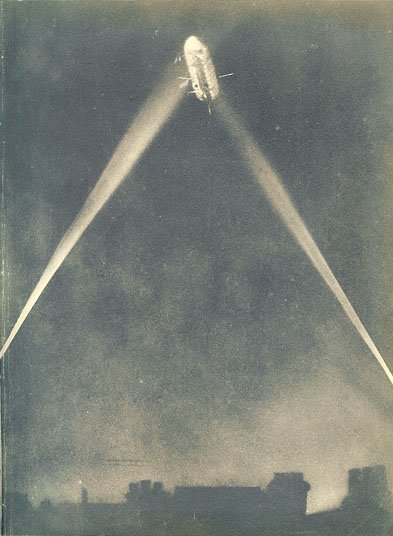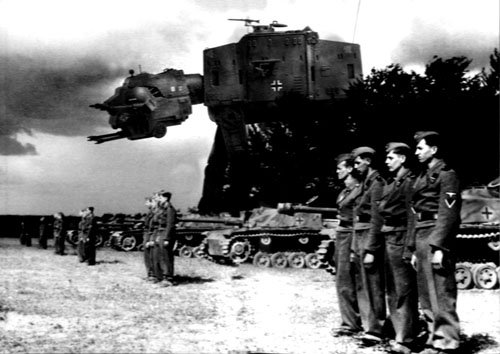Am I fake or not?
Photographs of actual combat in the First World War are exceedingly rare, in the air as well as on the ground. Both of these are purportedly of Zeppelins flying over Britain. Are they fake or not? My answers are below.

`The low down thing that plays the low down game'. Source: British postcard, Zeppelin im Krieg.

'Over London's roofs. London's defences against Zeppelin raids were never adequate. Searchlights sometimes succeeded in spotting the raiders, as in the actual photograph by an amateur shown in the impression on the opposite page, but the anti-aircraft guns never secured a direct hit. Zeppelin raiders were only checked and finally defeated by aeroplane attack'. Source: Hamilton Fyfe,"Early Zeppelin nights of terror", in John Hammerton, ed., War in the Air: Aerial Wonders of our Time (London: Amalgamated Press, n.d. [ca. 1935]), 17.
OK, I think the first one is a pretty obvious fake, for a number of reasons. Firstly, from the shape of the hull and the arrangement of the gondolas, it's clearly a pre-war model Zeppelin, and these took part in only the very earliest raids. Secondly, it's hanging down very low over a town or city, hardly standard operating procedure, as it would have been very vulnerable to anti-aircraft fire. Finally, it seems unlikely that a night-time photograh could be this clear, given the technology available, and there seems to be too much light on the Zeppelin. It would need a longish exposure time to gather up the required number of photons, but then it would be blurrier. My guess is that it's based on a retouched pre-war photograph of a Zeppelin.
I was initially more impressed by the second photo -- it seems more dynamic, less staged than the postcard. But upon reflection, I think it's a fake too. Like the first one, it's a bit too clear and bright for a night-time photo. Also, the airship looks too short and stubby for a Zeppelin. And finally, have a look at the searchlight beams -- they are very narrow and based on their low rate of divergence, the sources would have to be in mid-air, just off the edges of the photo. I guess the British could have mounted searchlights on tall towers -- but they didn't! So, my conclusion is that this is also a doctored photograph, possibly of a small British airship (though I haven't been able to find a good candidate).
Such photographs make sense as propaganda, official or unofficial (the first image above is even sanctioned by the 'Official Press Bureau'). Zeppelins were much discussed, sometimes heard, but very rarely seen, so people would have been curious to see what it was they had been imagining. This would have helped dispel some of the menace of the Zeppelin, which was based on its seeming ability to come and go as it pleased without being detected; showing them caught in the searchlights would have suggested their vulnerability. Other examples of faked air combat photos exist -- Rosebud has a number of them (including, I notice, the Zeppelin postcard above). This one is my favourite:
It's very well done, but not very plausible. Who is going to whip out their Box Brownie in the middle of a dogfight and manage to snap off such a well-focused shot? Even today, many of us have trouble taking non-blurry images with all the advantages of digital photography. No doubt the above image was created to satisfy public demand for images of aerial knights jousting in the skies. In modern parlance, it was photoshopped.
Which leads me to another problem with the two airship photos above: I don't know where they originally came from. The first one I found on the web, the second from a mid-1930s magazine, so in neither case do I have contemporary sources. They could even be post-war fakes, for all I know. Or in the case of the first one, a modern fake. I doubt that, in this case -- it's very well done, and of a very obscure subject, if so. But the point is that modern technology makes it much easier to fake a photo (though it can make it easier to detect trickery, as well). The easier something is to do, the more likely it is that people will do it. And so we get images like this one (from here):
OK, so this presumably was never meant to fool anyone (!), and it's still not entirely convincing, but it shows what can be done. There are plenty of other examples around, some for fun, some perhapsnot. Of course, the best way to guard against being taken in by such images is to check their provenance and their context, the same with any piece of historical evidence. Can the original source for the image be traced? Does the content fit into what is known about the period? If not, then no weight can be placed upon it. This will not exactly be a revelation to historians, but it's surprising how many people still believe that images speak for themselves.